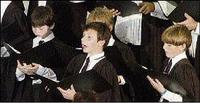Michael Reckord, Gleaner Writer
The Kingston College Chapel Choir performs at 'The Christ Church Cathedral Choir, Oxford, in Concert', held at the Holy Trinity Cathedral, North Street, Kingston on Sunday. The event was held in association with the Jamaica National Building Society (JNBS). - Winston Sill/Freelance Photographer
We probably can assume there was no competitive element in last Sunday's concert at Holy Trinity Cathedral put on by two top school choirs. One was the Christ Church Cathedral Choir from Oxford, England; the other, the Kingston College Chapel Choir from Jamaica.
Certainly nothing was officially done or said to suggest that there was competition between the two. However, when a member of the audience in the jam-packed church opined that the quality of the local choir matched the visitors' song for song, this reviewer, himself a KC old boy, was quick to agree.
Undoubtedly, there was a shade of difference between them, but no one would deny that Kingston's 60-year-old, 34-strong choir compared favourably with Oxford's 500-year-old, 28-strong singing group.
The British choir was invited to Jamaica as part of Kingston College's celebration of its choir's 60th anniversary. Together the two choirs presented a technically fine, well-received 21-item concert. Only two were not sung, as they were organ pieces by J.S. Bach (played by Edward Tambling) and C.M. Widor (played by Clive Driskill-Smith), both men coming with the visiting choir.
Frequent and sometimes prolonged applause by the audience indicated pleasure in the singing. Still, the programme was uniformly serious, religious in fact, and in that sense it lacked variety.
Versatility

Members of the Christ Church Cathedral Choir from Oxford, England, perform at 'The Christ Church Cathedral Choir, Oxford in Concert', held at the Holy Trinity Cathedral, North Street, Kingston, last Sunday. The event was held in association with the Jamaica National Building Society (JNBS).
The most light-hearted song listed on the printed programme, It was a Lover and His Lass (Rutter), intended to be the final item, was not sung. It was replaced by yet another religious item, an anthem from Handel's oratorio, Zadok the Priest. While this item is in a "higher class" then Rutter's and was powerfully rendered, a chance was missed to show the choirs' versatility. After all, the item directly preceding it was Handel's sublime Hallelujah Chorus.
The visiting choir began the concert with Christe Jesu Pastor Bone by John Taverner. Because of the piece's historical interest, I quote the first three sentences of the programme nates:
"John Taverner (c. 1490 - 1545) was the first organist and master of the choristers at Christ Church when the college was founded by Cardinal Wolsey in 1526. The antiphon, Christe Jesu Pastor Bone was sung every evening as part of the liturgy in the college and contained an invocation to the cardinal's patron saint, St. William of York. The text of the piece was subsequently adopted twice, first when Henry V111 re-founded the college in 1546, and secondly when Queen Elizabeth 1 came to the throne."
The composers chosen for the programme spanned the centuries from the 15th to the present and, as well as Handel, included well known names such as Bach, Purcell, Haydn, Grieg, Britten and Vaughan Williams. Jamaican Noel Dexter's Psalm 150 was performed admirably by the KC choir.
It is no surprise that the two choirs sang superbly, but I found myself being irritated by most of the pieces which were accompanied by the organist. I thought this was because the organ was overwhelming the voices, a problem I often find in concerts, especially with young choirs.
Slight delay
But a half-time chat with a couple of musicians gave me another reason. They heard something I had not been conscious of, a slight delay between the organ music and the voices, caused, they suggested, because the organist was so far from the choir. The two were separated by nearly the full length of the large cathedral.
Whatever the reason, I definitely enjoyed the several a cappella items more than the accompanied ones. The former included Hosanna to the Son of David (T. Weelkes, 1576 - 1623), Justorum Animae (C.V. Stanford, 1852 - 1924), Ave Maris Stella (E. Grieg, 1843-1907) and Set Me A Seal (W. Walton, 1902-1983). Without the organ, the full range and beauty of the singers could be appreciated.
At the same time, the closing couple of works would have been less magnificent without the backing of the sonorous organ.

